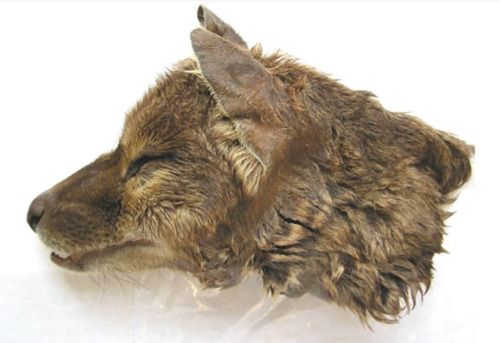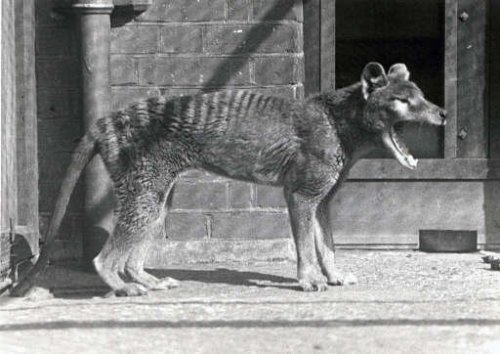Model Of Thylacine With Mouth Agape, Displayed At The Kitakyushu Museum Of Natural History And Human

Model of thylacine with mouth agape, displayed at the Kitakyushu Museum of Natural History and Human History in Fukuoka, Japan.
Via @hakubutu on Twitter.
More Posts from Moonlight-wolf-archive and Others

The central continent of my worldbuilding world is dominated by marsupials and monotremes, and birds. There are several species of thylacine, and one — which is essentially our Thylacinus cynocephalus — is domesticated.
They are a recent domestication, with about 250 generations having passed. Compared to the wild ancestors, they have similar builds, but with more colours, variation in size, and longer lifespans (12-20 years). They have lost their natural reclusive nature and though shy, are friendly and inquisitive and trainable to a point. Most prefer to be solitary or tolerate the presence of 1-2 others, though get along well with other calm-tempered species. Their prey drive is greatly reduced but many suffer anxiety in loud or busy environments.

The Brighton Thylacine. This specimen lives in the Booth Natural History Museum and is on display at the time of writing. The collection consists of natural history specimens collected by several Victorian collectors,(mostly taxidermy birds) plus others donated and found by locals. The museum now is themed around conservation and education.
The Thylacine was collected and mounted in the 1870s and is sadly quite faded, it is missing it’s stripes, though there is a chance it might not have had any. The feet are well preserved, as is it’s face. The display allows you to get close. I took more detailed photos which I will post.
LOST THYLACINE FOOTAGE REDISCOVERED
Originally shot by Dr. Randle Stewart, an Australian psychiatrist, whilst on honeymoon in Tasmania, these 18 seconds of combined footage show the last captive thylacine in the world.
Commonly referred to as “Benjamin”, the individual lived at the now-abandoned Beaumaris Zoo from the early 1930s to his death in September of 1936, incidentally the same year thylacines were granted official protection by the Australian government.
The footage, shot in 1931, had been considered lost since the late 1970s.



Sunbathing thylacines

Charles R. Knight (1874-1953), Tasmanian Wolf and Cubs

BRUH????

Tasmanian Tiger Thylacinus cynocephalus Source: Here
eyesperceive:
well this is an interesting animal… thylacine



Preserved head of a female thylacine at Oxford University Museum of Natural History and a photo of the same animal when she was alive. This individual was captured in 1925 and sold to Beaumaris Zoo in Hobart, before being transferred to London Zoo in 1926. She died on the 9th of August, 1931. She was the last living thylacine to be exhibited outside of Australia.
Top photo by S. Sleightholme
This is an awesome book
I definitely recommend it
Sorry if you’ve already said, but what’s the book you’ve been reading about thylacines?

-
 xerxesean-imals liked this · 4 months ago
xerxesean-imals liked this · 4 months ago -
 gaywarrren liked this · 1 year ago
gaywarrren liked this · 1 year ago -
 its-always-the-witching-hour liked this · 1 year ago
its-always-the-witching-hour liked this · 1 year ago -
 shreddheir reblogged this · 2 years ago
shreddheir reblogged this · 2 years ago -
 thylawhiskers reblogged this · 2 years ago
thylawhiskers reblogged this · 2 years ago -
 thylawhiskers liked this · 2 years ago
thylawhiskers liked this · 2 years ago -
 justgoji reblogged this · 2 years ago
justgoji reblogged this · 2 years ago -
 justgoji liked this · 2 years ago
justgoji liked this · 2 years ago -
 m0th-kid liked this · 2 years ago
m0th-kid liked this · 2 years ago -
 siberiantrap reblogged this · 2 years ago
siberiantrap reblogged this · 2 years ago -
 mosscoveredcockring reblogged this · 2 years ago
mosscoveredcockring reblogged this · 2 years ago -
 mosscoveredcockring liked this · 2 years ago
mosscoveredcockring liked this · 2 years ago -
 fire-around-us reblogged this · 2 years ago
fire-around-us reblogged this · 2 years ago -
 my-chemical-rot reblogged this · 2 years ago
my-chemical-rot reblogged this · 2 years ago -
 honeycomb-butch reblogged this · 2 years ago
honeycomb-butch reblogged this · 2 years ago -
 bucet-with-face liked this · 2 years ago
bucet-with-face liked this · 2 years ago -
 allosauroid liked this · 2 years ago
allosauroid liked this · 2 years ago -
 couldntthinkofatitle liked this · 2 years ago
couldntthinkofatitle liked this · 2 years ago -
 distelig reblogged this · 2 years ago
distelig reblogged this · 2 years ago -
 distelig liked this · 2 years ago
distelig liked this · 2 years ago -
 alienhoarder liked this · 2 years ago
alienhoarder liked this · 2 years ago -
 anarchoanimatronic reblogged this · 2 years ago
anarchoanimatronic reblogged this · 2 years ago -
 anarchoanimatronic liked this · 2 years ago
anarchoanimatronic liked this · 2 years ago -
 fartcowboy liked this · 2 years ago
fartcowboy liked this · 2 years ago -
 verdaneart liked this · 2 years ago
verdaneart liked this · 2 years ago -
 deathangel222 liked this · 2 years ago
deathangel222 liked this · 2 years ago -
 gorefuckmetalhead222 liked this · 2 years ago
gorefuckmetalhead222 liked this · 2 years ago -
 howmanyyams liked this · 2 years ago
howmanyyams liked this · 2 years ago -
 welcometothewarren liked this · 2 years ago
welcometothewarren liked this · 2 years ago -
 brewshrew liked this · 2 years ago
brewshrew liked this · 2 years ago -
 prodigalhound liked this · 2 years ago
prodigalhound liked this · 2 years ago -
 khaosindigo liked this · 2 years ago
khaosindigo liked this · 2 years ago -
 kingofthecobras liked this · 2 years ago
kingofthecobras liked this · 2 years ago -
 greer-art liked this · 2 years ago
greer-art liked this · 2 years ago -
 introvertia liked this · 2 years ago
introvertia liked this · 2 years ago -
 rawdoggingcardinals liked this · 2 years ago
rawdoggingcardinals liked this · 2 years ago -
 beardless-bearded-vulture reblogged this · 2 years ago
beardless-bearded-vulture reblogged this · 2 years ago -
 gilbull liked this · 2 years ago
gilbull liked this · 2 years ago -
 keone2012 liked this · 2 years ago
keone2012 liked this · 2 years ago -
 moonlight-wolf-archive reblogged this · 2 years ago
moonlight-wolf-archive reblogged this · 2 years ago -
 rhincodon-cynocephalus liked this · 2 years ago
rhincodon-cynocephalus liked this · 2 years ago -
 lesbiannemesis liked this · 2 years ago
lesbiannemesis liked this · 2 years ago -
 glitchinthevisuals liked this · 2 years ago
glitchinthevisuals liked this · 2 years ago -
 prepkitten reblogged this · 2 years ago
prepkitten reblogged this · 2 years ago -
 prepkitten liked this · 2 years ago
prepkitten liked this · 2 years ago -
 5millioncatipilars liked this · 2 years ago
5millioncatipilars liked this · 2 years ago -
 luimnigh liked this · 2 years ago
luimnigh liked this · 2 years ago -
 kaen-ace-of-diamonds reblogged this · 2 years ago
kaen-ace-of-diamonds reblogged this · 2 years ago -
 feralhissingnoises reblogged this · 2 years ago
feralhissingnoises reblogged this · 2 years ago -
 feralhissingnoises liked this · 2 years ago
feralhissingnoises liked this · 2 years ago

Collection of media revolving around the Thylacine
149 posts